Shrimp Jambalaya – Juicy shrimp and sausage, Creole seasonings, sauteed veggies, perfectly cooked rice, and (spoiler alert, here comes the secret ingredient) homemade shrimp broth make for a dish that will have you coming back for seconds or even thirds. This dish is way easier than most folks think and packs a real flavor punch! 🤩

If you’ve ever been to NOLA, you’ve probably tasted (and fallen in love with) shrimp jambalaya. My passion for the dish started in the city of jazz too, so I’m so excited to share this recipe with you. I promise it will transport you right back to New Orleans, no matter where you are.
Word to the wise: don’t let this recipe intimidate you! Sure, there are quite a few ingredients, but the actual cooking process is ridiculously easy. If you can sauté, you can make this shrimp jambalaya. Plus, all those ingredients add up to some serious flavor. 🤤

More Reasons to Love Shrimp Jambalaya
Shrimp jambalaya is a one-pot meal, so you won’t need to wash a ton of pots and pans once it’s ready. It also makes a huge meal, enough to feed a crowd or at least end up with a sizeable amount of leftovers. That’s always a win in my book! 🙌
This dish also keeps really well in the fridge and reheats nicely, so you can put those leftovers to good use. Finally, it’s super customizable, so you can customize the proteins, seasonings, and just about anything. More on this later.😉
Recipe Ingredients

- Shrimp and Sausage – One pound of raw shrimp or prawns and 12 ounces of Andouille sausage are my choices because they add just the right layers of flavors to please my taste buds.
- Veggies – You’ll need the holy trinity for this one: celery, onion, and bell pepper, along with some garlic and a can of crushed tomatoes.
- Seasonings – Bay leaves, thyme, and some Creole seasoning are all you need to welcome your guests to flavor city.
- Broth – Don’t throw out your shrimp shells or veggie scraps because you’ll use them to make amazing homemade shrimp broth to cook the rice. 😋
How to Make Shrimp Jambalaya

Make the Shrimp Stock
- Seasonings – Add 1-2 teaspoons of butter or oil to a saucepan or skillet. Then throw in the shrimp shells, the remaining scraps of onion, garlic, celery, and aromatics like bay leaf and thyme. (Photos 1-2)
- Sauté for about 5-7 minutes, stirring constantly to keep it from burning.
- Add Liquid – When the scraps are soft, add 4-5 cups of water to the pan. (Photo 3)
- Simmer – Bring everything to a boil, lower the heat, and let it simmer for 10- 20 minutes. (Photo 4)
- Reserve – Sieve and reserve the stock.
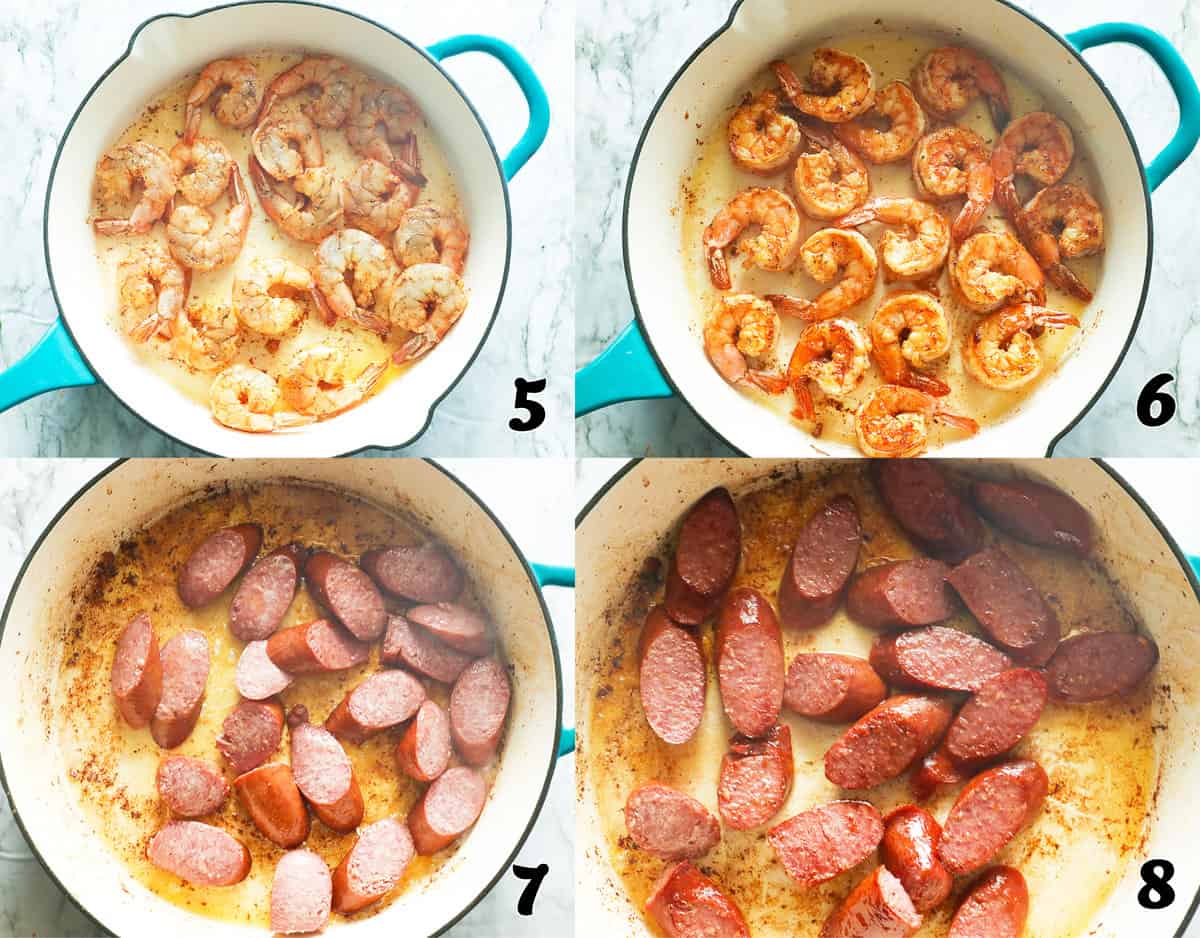
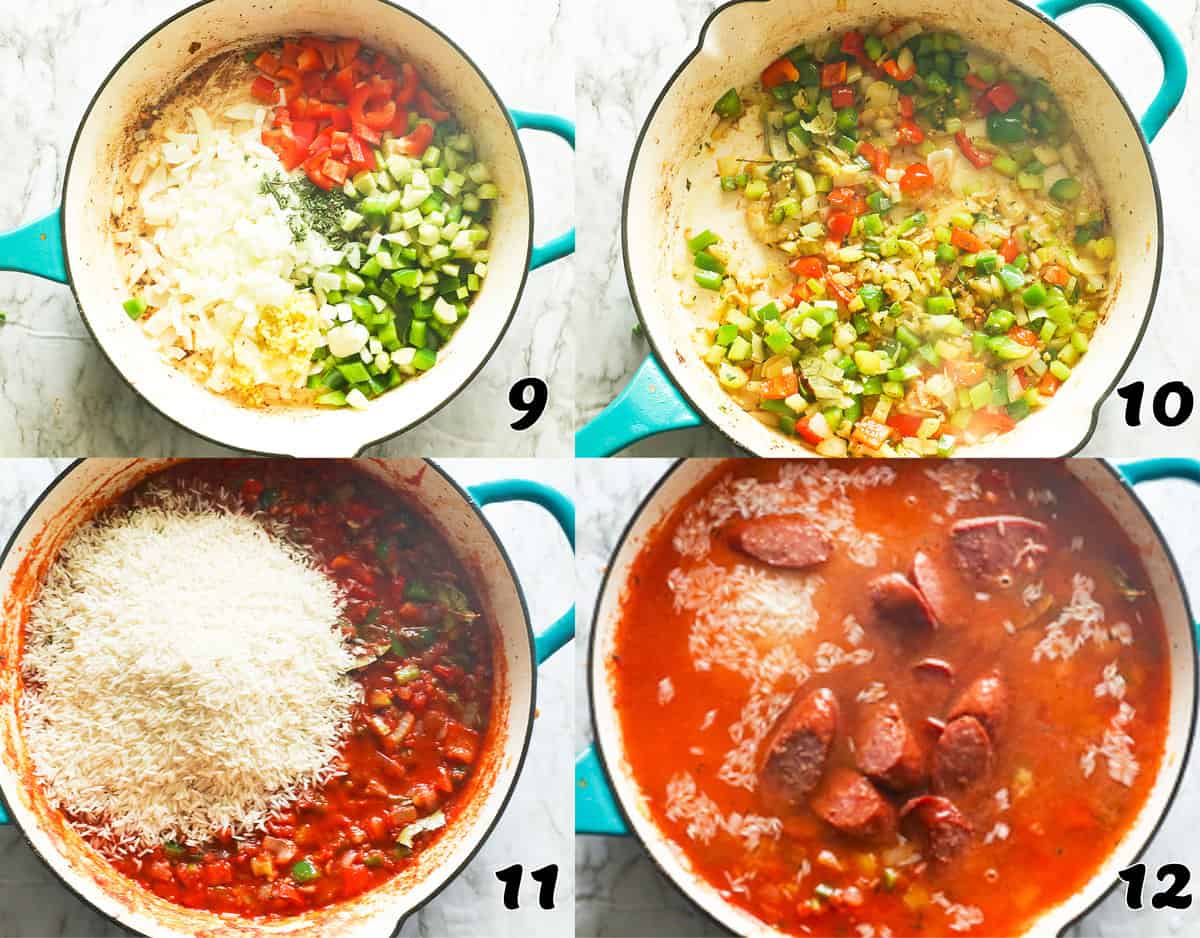
Shrimp Jambalaya
- Season Shrimp – Place the shrimp in a plate or bowl—then season with salt, pepper, and Creole seasoning. Toss to coat evenly and set aside.
- Prep Skillet – Heat a heavy pot (skillet, Dutch oven, or another oven-safe pot) over medium heat. Add about 2 tablespoons of oil to the skillet.
- Saute Sausage – Add the sausage and brown for a few minutes when the oil is hot. Then remove the sausage and set it on a plate. (Photos 7-8)
- Sautee Shrimp – Add the shrimp to the same pan and brown for 2-3 minutes. Then remove them and place them on the plate with the sausage. (Photos 5-6)
- The Holy Trinity – Add more oil to the pan, then add the onions, celery, and bell pepper. Sauté for about 2-3 minutes, and then add garlic, thyme, and bay leaf. Continue cooking for 4-5 minutes. (Photos 9-10)
- Rice – Then stir in the rice and crushed tomatoes, followed by shrimp stock, Creole seasoning, salt, and pepper. (Photo 11)
- Add Sausage – Return the sausage to the pot. Bring it all to a boil before reducing the heat to barely a simmer. Cover and cook for about 15 minutes. (Photo 12)
- Add Shrimp – Then add the shrimp on top of the jambalaya and gently stir it in.
- Final Stretch – Cover the jambalaya with a lid and continue cooking while occasionally stirring until the shrimp is pink and cooked through. It will take 4-5 minutes, depending on the size and thickness of the shrimp you use.
- Serve – Finally, remove the dish from the heat, sprinkle it with green onions and parsley, and serve warm.
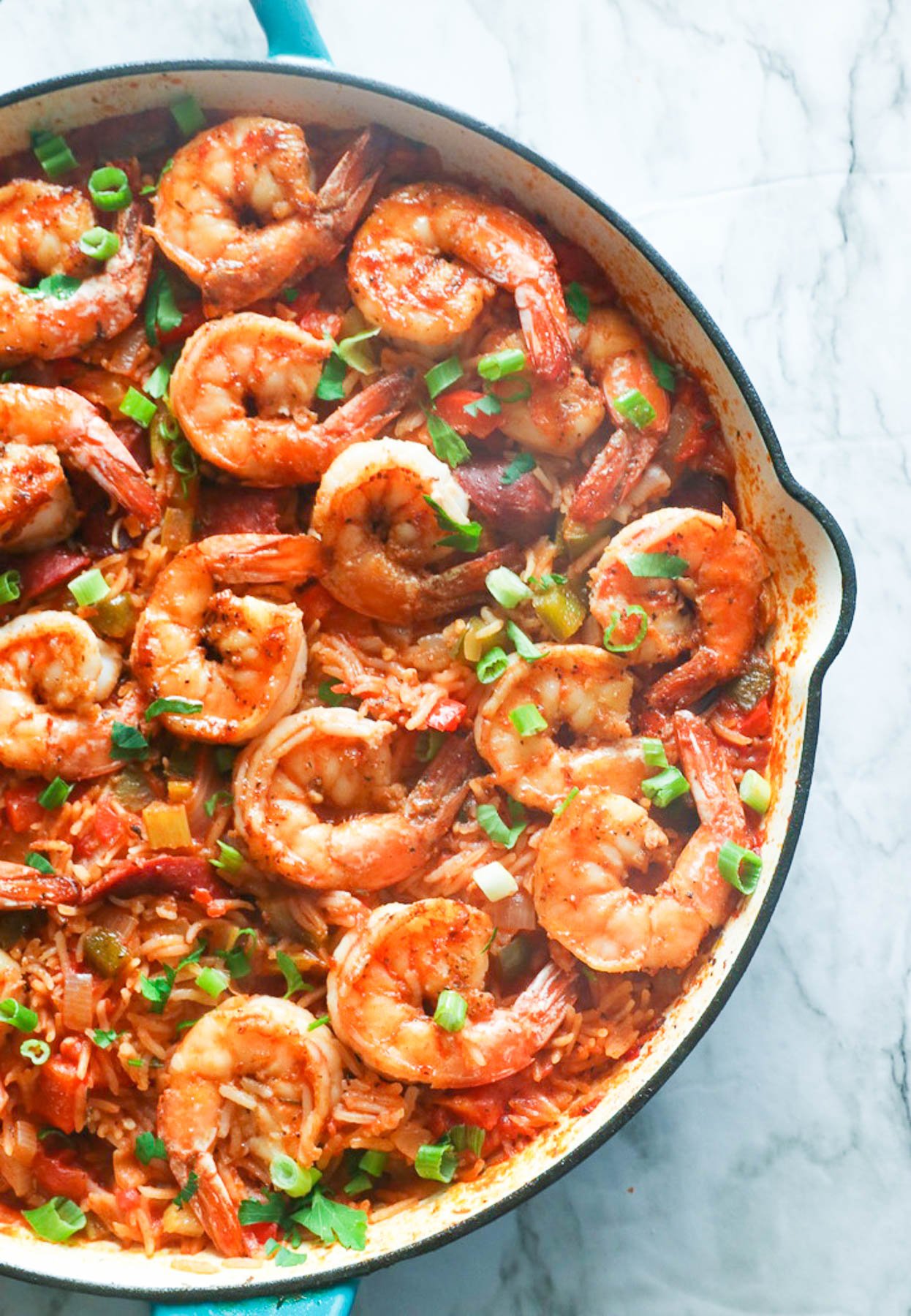
Recipe Variations
- Swap out the shrimp for chicken or your favorite seafood! Add whatever you like here, but I do recommend keeping the Andouille sausage and the holy trinity veggies, so you get that classic jambalaya flavor. 👌
- Instead of regular white rice, you could use parboiled rice for this recipe. I’d stay clear of more flavorful rice, though, such as jasmine or basmati, since they will alter the taste of this classic Creole dish. You could use brown rice, but keep in mind it will change the cooking time and also the overall flavor and texture.
Tips and Tricks
- Rinse your rice under running water until the water runs clear. Rinsing will eliminate some of the starch and help the rice become more fluffy and less sticky as it cooks, which is better for this dish.
- Keep your eye on the shrimp as it cooks because you don’t want them to overcook and get tough and chewy. Keep the stove burner on the bare minimum heat for those last five minutes, or turn it off completely if your stove runs hot. Keep the lid on and let them slow cook until they are perfectly pink and tender. 🦐
- For your cooking oil, stick with a neutral flavor that won’t mess with the jambalaya flavor. Butter, olive oil, or vegetable oil work great. But avoid coconut and other flavorful oils.
Make-Ahead Instructions
You can make this a few days ahead and store it in the fridge in an airtight container. It actually tastes better the next day. Then reheat serving-size amounts in the microwave or reheat the whole pan of food on the stove on low or medium heat. Stir occasionally to keep it from sticking to the bottom and burning.
Serving and Storage Instructions
Serve jambalaya warm and garnish it with chopped green onions and parsley. Then store leftovers in an airtight container in the fridge for 3-5 days.
You can also freeze shrimp jambalaya in an airtight container for two months. Reheat your delicious leftovers on the stove or in the microwave.
Extra tip: Reheating the shrimp separately might be a good idea so they don’t overcook and get rubbery.
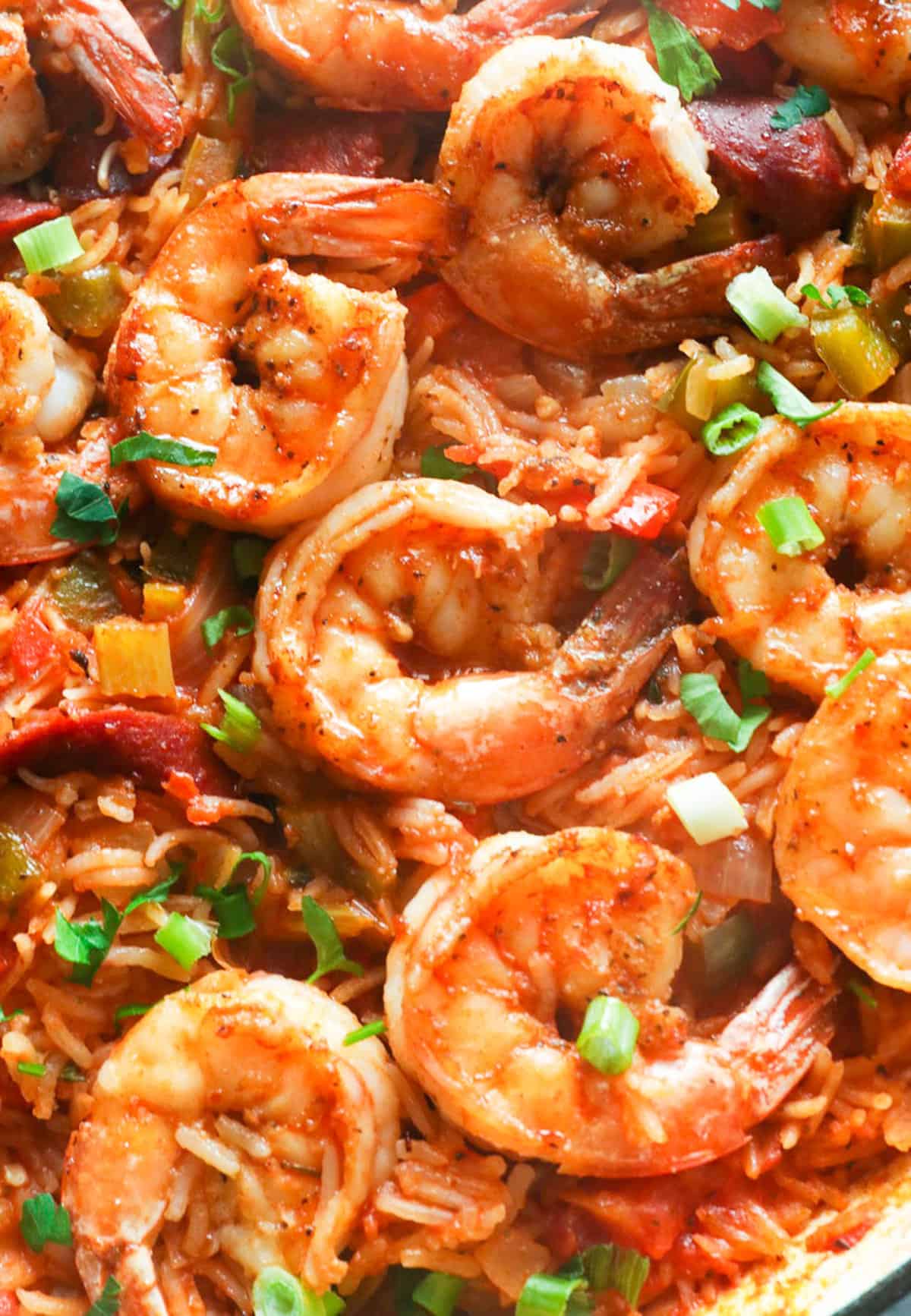
FAQs
When cooked properly, jambalaya is moist but never soupy or goopy. There should be just a touch of moisture left from the shrimp broth and tomatoes when it’s finished cooking.
Gumbo, another of my favorite Creole dishes, is like a stew served with rice. With jambalaya, the rice is already incorporated into the dish.
There are two main versions of jambalaya. Creole jambalaya (sometimes called red jambalaya) is associated with New Orleans. Brown jambalaya, with no tomato, is more popular in other parts of Louisiana.
What Goes With Shrimp Jambalaya
I like simple side dishes because they let the jambalaya really shine. A side of homemade cornbread and collard greens will complete the meal.
Side salads are also nice with jambalaya. So try a simple wedge or kale salad to balance out the comforting warmth of the jambalaya with something fresh and crunchy.
P.S. Don’t forget the sweet iced tea. 😉
More Crazy Delicious Creole Recipes to Try
Conclusion
Bring all the flavors of New Orleans home with this classic jambalaya recipe. Are you a big fan of Southern soul food? If so, follow me on Facebook and Instagram for more recipes like this one!
Watch How to Make It
[adthrive-in-post-video-player video-id=”buYWqx6v” upload-date=”2023-03-07T16:10:09.000Z” name=”SHRIMP JAMBALAYA.mp4″ description=”null” player-type=”collapse” override-embed=”false”]
Shrimp Jambalaya
Ingredients
Shrimp
- 1 pound (500g) raw shrimp or prawns, tails on or off (peeled and shells reserved)
- Salt and pepper to taste
- 1-2 teaspoons Creole seasoning, salt-free
Jambalaya
- ¼ cup oil
- 12 ounces (340g) Andouille sausage, sliced into rounds
- 1 medium onion, diced
- 1 large green bell pepper, seeded
- 2 stalks celery, diced
- 4-5 cloves garlic, minced (about 1½ tablespoons garlic)
- 2 teaspoons thyme, minced
- 2-3 bay leaves
- 1½ cups uncooked white rice (short or long grain)
- 1 14-ounce can (400g) crushed tomatoes
- 1-2 teaspoons hot pepper sauce (adjust to tastes)
- 1 tablespoon Worcestershire sauce
- 3 cups shrimp stock (or chicken broth)
- Sliced green onions and chopped parsley, to garnish
- Salt and pepper to taste
Instructions
Shrimp Stock
- Add 1-2 teaspoons of butter or oil to a saucepan or skillet. Then throw in the shrimp shells, the remaining scraps of onion, garlic, celery, and aromatics like bay leaf and thyme.
- Sauté for about 5-7 minutes, stirring constantly to prevent burning.
- When the seasonings soften, add 4-5 cups of water to the pan.
- Bring everything to a boil, lower the heat, and let it simmer for 10- 20 minutes.
- Strain and reserve the stock.
Jambalaya
- Place the shrimp in a plate or bowl. Season with salt, pepper, and Creole seasoning. Toss to coat evenly and set aside.
- Heat a heavy pot (skillet, Dutch oven, or another oven-safe pot) over medium heat. Add about 2 tablespoons of oil to the skillet.
- Add the sausage and brown for a few minutes when the oil is hot. Then remove the sausage and set it on a plate.
- Add the shrimp to the same pan and brown for 2-3 minutes. Then remove them and place them on the plate with the sausage.
- Add more oil to the pan, then add the onions, celery, and bell pepper. Sauté for about 2-3 minutes, and then add garlic, thyme, and bay leaf. Continue cooking for 4-5 minutes.
- Next, stir in the rice, crushed tomatoes, hot pepper sauce, and Worcestershire, followed by shrimp stock. Add Creole seasoning, salt, and pepper to taste.
- Return the sausage to the pot. Bring it all to a boil before reducing the heat to barely a simmer. Cover and cook for about 15 minutes.
- Next, add the shrimp on top of the jambalaya and gently stir it in.
- Cover the jambalaya with a lid and continue cooking while occasionally stirring until the shrimp is pink and cooked through. It will take 4-5 minutes, depending on the size and thickness of the shrimp you use.
- Finally, remove the dish from the heat, sprinkle it with green onions and parsley, and serve warm.
Tips & Notes:
- Rinse your rice under running water until the water runs clear. Rinsing will eliminate some of the starch and help the rice become more fluffy and less sticky as it cooks, which is better for this dish.
- Keep your eye on the shrimp as it cooks because you don’t want them to overcook and get tough and chewy. Keep the stove burner on the bare minimum heat for those last five minutes, or turn it off completely if your stove runs hot. Keep the lid on and let them slow cook until they are perfectly pink and tender.
- For your cooking oil, stick with a neutral flavor that won’t mess with the jambalaya flavor. Butter, olive oil, or vegetable oil work great. But avoid coconut and other flavorful oils.
- Please remember that the nutritional information is a rough estimate and can vary significantly based on the products used in the recipe.
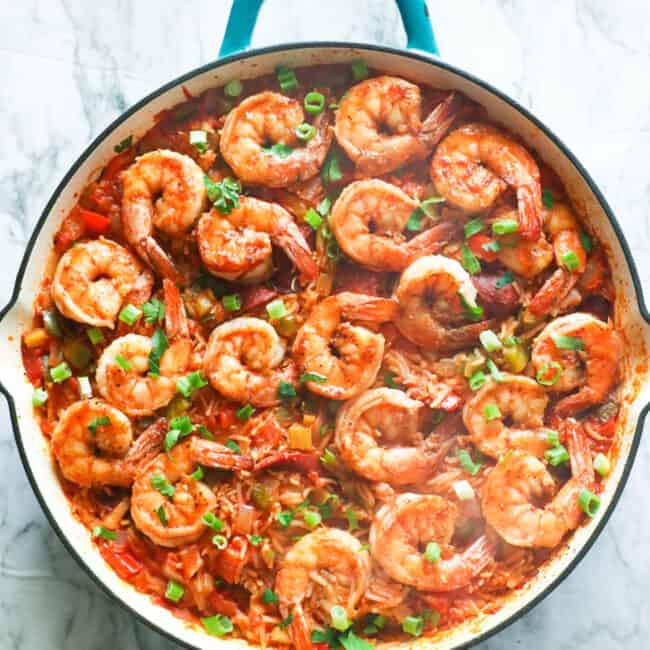
Jan Plyler says
Made it last evening
Amina Akhter says
Wow,, My whole family loved this recipe 🙂
Imma says
Aww lovely to hear that 🙂
Jen English says
Hi,
I’m in the middle of making this recipe and in putting it together you never mention the chicken stock, Worcestershire sauce & hot sauce… please respond ASAP regarding these items, especially the chicken stock.
Imma says
Sorry about that. It should have read shrimp stock. And you add the rest at the same time. I will fix the recipe. Thanks for pointing that out.